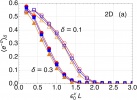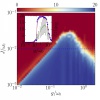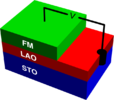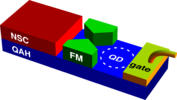Research Topics
We seek physical principles and methods for coherent manipulation of quantum states of mesoscopic systems, and study
the effects of such manipulation on various phenomena including quantum transport and quantum information processing.
More specific fields are:
- Quantum Computation and Quantum Information.
- Quantum Transport in Mesoscopic Systems.
- Superconductivity and Superconducting Quantum Circuits.
- Spin Transport and Quantum Information Processing with Spins.
Research Highlights
Not Just Violation, But Violation with Style
- June 14, 2016
- Scientific Reports 6, 27603 (2016)
The Jarzynski equality holds for ridiculously general cases, essentially for any non-equilibrium dynamic processes. Prof. Mahn-Soo Choi and his student Seungju Han in an international collaboration find the violation of the Jarzynski equality over second-order phase transitions, where the violation exhibits a scaling law inherited from the spontaneous symmetry breaking. The rare violation of the Jarzynski equality was pointed out previously for a rather unrealistic or physically uninteresting models, but the present work reveals a universal violation in a wide range of physical models.
Prof. Choi Organizes a Special Issue of Physics & High Technology as the Guest Editor
- May 30, 2016
- Physics & High Technology (May 2016)
After nearly a decade of topological insulators, physicists are now looking into topological semimetals, three dimensional metals with Weyl particles as elementary excitations. Chiral anomaly and surface Fermi arcs are two of many examples of topological features.
As condensed matter physics falls in love with topology, Prof. Mahn-Soo Choi, as the Guest Editor, has organized a special issue of Physics and High Technology published by the Korea Physical Society. He himself wrote an article in the issue together with his former postdoc Prof. Minchul Lee at Kyunghee University. In 2011, he had written a review article in another special issue (on topological insulator) of the same magazine.
Stronger Coupling Sets Free Photons Back
- April 12, 2016
- Physical Review Letter 116, 153601 (2016)
Just like photons mediate the interaction between charged particles, qubits do so among photons. The qubit-mediated force is repulsive and has been known to cause the photon blockade effect. Prof. Mahn-Soo Choi in collaboration with his former student Dr. Myung-Joong Hwang at Univ of Ulm, Germany and Prof. Myungshik Kim at Imperial College London reveals in a recent Physical Review Letter article that as the photon-qubit coupling gets even stronger, the interaction decreases back and photons get free of it.
Negative Tunneling Magneto-Resistance (TMR) in LAO/STO
- Jun 12, 2015
- Nature Communications (2015)
The spin selection rule prevents up-spin electrons from tunneling to the sea of down-spin electrons. This leads to positive tunneling magneto-resistance (TMR). In a coming article of Nature Communications, a KRISS team led by Dr. Jinhee Kim reports experimentally and Mr. Seungju Han and Professor Mahn-Soo Choi of KU Physics explain theoretically an exotic negative and anisotropoic TMR in LAO/STO interface. LAO/STO interface is remarkable in that it can be superconducting and ferromagnetic at the same time.
Majorana Stands Out In a Quantum RC Circuit
- Aug 27, 2014
- Phys Rev Lett 113 (7), 076801 (2014)
Majorana is an exotic fermion that is its own anti-particle. Neutrino is argued to be the only elementary particle of such kind and yet to be confirmed. Majorana as an elementary excitation has been witnessed in condensed matters and yet to be verified.
In a recent Physics Review Letters paper, Prof. Mahn-Soo Choi in KU Physics and his collaborator Prof. Minchul Lee at Kyung Hee University reveal another striking traits of Majoranas that can be seen in a quantum RC circuit.
Seeking Majorana Fermions
- Sep 30, 2011
- Physical Review Letters 107, 136403 (2011)
Domain walls between superconducting and magnetic regions placed on top of a topological insulator support transport channels for Majorana fermions. We propose to study noise correlations in a Hanbury Brown–Twiss type interferometer and find three signatures of the Majorana nature of the channels. First, the average charge current in the outgoing leads vanishes. Furthermore, we predict an anomalously large shot noise in the output ports for a vanishing average current signal. Adding a quantum point contact to the setup, we find a surprising absence of partition noise which can be traced back to the Majorana nature of the carriers.
Older Topics
Below there are some old topics. Some of them are not actively studied these days in our group.
Macroscopic Quantum Phenomena and Quantum Phase Transitions
This study involves the novel effects of quantum fluctuations and quantum dynamics of vortices in the arrays of ultrasmall superconducting tunnel junctions which, among many examples, have provided a prototype system displaying macroscopic quantum phenomena and quantum phase transitions. In light of current trends toward submicron scales, disorder effects have become very important in mesoscopic systems. The study of such effects could include the c-axis transport problem in high-temperature superconductors, as involved in a recent work of mine. Another problem of my concern is the effects of frustration, which may come from the external magnetic field applied to, e.g., two-dimensional superconducting arrays, or from the geometric configuration in, e.g., coupled chains of mesoscopic tunneling junctions. Some of my recent works on coupled chains have demonstrated the richness of physics in such systems. Other topics of my interest also include the structural and dynamic properties of vortices in unconventional superconductors. Although devoted mainly to analytical works, I have lately become interested in the density-matrix renormalization group method, a numerical technique developed enormously in recent years. Below, I enlist in a little more detail several topics of my interest.
Coulomb Blockade and Quantum Phase Transitions
Systems of ultrasmall tunnel junctions, either metallic or superconducting, have attracted considerable interest, owing to the Coulomb blockade effect which exhibits single charge (electron or Cooper pair) tunneling. In particular, the phase-coherent nature of the Cooper pair tunneling, competing with the strong phase fluctuations due to the charging energy, leads to quantum phase transitions between the superconductor (S) and the insulator (I) (SI). In collaboration with Prof. M. Y. Choi at Seoul National Univeristy and others, I showed that a one-dimensional (1D) chain with both self- and junction capacitances exhibits SI transitions of the Berezinskii-Kosterlitz-Thouless type. Very recently, I have also been working on the finite-temperature crossovers in such systems by means of the Feynman-Kleinert variational method. Another fascinating role of the Coulomb interaction is revealed in two chains of tunnel junctions coupled by large inter-array capacitances. In recent works, we have suggested that the cotunneling of charges (excess or deficit Cooper pairs) along the two chains plays major roles in transport and even drives SI transitions. The coupled-chain problem is also of interest from the point of view that the system can be transformed to various quantum models, such as spin-1 or spin-1/2 XXZ chains and spin1/2 ladders, depending to the parameter regimes. Further interest in the coupled chains comes from the (geometric) frustration, which has been shown to affect the quantum phase transitions. Putting all together, I am much interested in quantum many-body problems in a variety of 1D systems at mesoscopic scales.
Quantum Dynamics of Vortices
Problems on both classical and quantum dynamics of vortices in superconducting arrays and films have been of great interest. The long-lasting problem of Hall anomaly in films still remains to be resolved, casting challenging questions on magnus force and the effective mass of a vortex. Furthermore, in arrays of ultrasmall junctions, quantum interference of vortices has been observed experimentally, demonstrating the quantum nature of vortices. It has also been argued that vortices as bosons display the quantum Hall effect and that the geometric phase has a great influence on the quantum dynamics of vortices. Recently, in collaboration with Prof. M. Y. Choi, I studied how the dissipative dynamics appears in the macroscopic description of a quantum vortex, starting from a microscopic model. Considering the significant roles of vortices in such systems, I am much interested in carrying on research on quantum dynamics of vortices, including the effective mass and macroscopic tunneling of vortices.
Unconventional Superconductors
Despite the considerable efforts ever since the discovery of the high-temperature cuprates, the superconducting mechanism still remains unclear. Based on the symmetries inherited from the system, however, the phenomenological descriptions in terms of the Ginzburg-Landau theory for the superconducting order parameter have achieved great success. The phase-sensitive experiments to determine the symmetry of the superconducting pairing state demonstrates one of such success. Covering various unconventional superconductors, independently of the microscopic mechanism behind the superconductivity, such a description has been applied to problems of unconventional Josephson effects, vortex structures, and magnetic properties. In my work on two coupled order parameters, I studied the vortex structures and corresponding magnetizations in d-wave superconductors. The critical behavior of such a phenomenological model, especially in highly-layered superconductors, is also of much interest.





